Shahed 129
| Shahed 129 | |
|---|---|
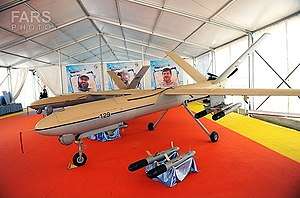 | |
| The first generation Shahed 129. | |
| Role | Combat / Intelligence / Surveillance / Reconnaissance (CISR)[1] |
| National origin | Iran |
| Manufacturer | HESA[2] |
| Designer | Shahed Aviation Industries Research Center[3] |
| First flight | Spring 2012[3] |
| Status | In service, in production |
| Primary user | Iran |
| Produced | 2012-present |
| Number built | 22/40 (2017)[3] |
| Developed from | Shahed 123[3] |
The Shahed 129 (Persian: شاهد ۱۲۹, English: "Eyewitness") is an Iranian single-engine medium-altitude long-endurance unmanned combat aerial vehicle (UCAV) designed by Shahed Aviation Industries for the Islamic Revolutionary Guard Corps (IRGC). The Shahed 129 is capable of combat and reconnaissance missions and has an endurance of 24 hours. In size, shape and role, it is similar to the American MQ-1 Predator drone.[4]
Development began in the late 2000s. It first flew in spring 2012 and was in limited service performing surveillance over Syria two years later.[3] The UAV suffered problems with its planned armament and did not make any drone strikes until early 2016, when new Sadid-345 precision-guided munitions were integrated.
The UAV has been used in the Syrian Civil War and for border patrol on Iran's eastern border.[3] The Shahed 129 is widely considered the most capable drone in Iranian service, and together with the Saegheh is expected to form the backbone of Iran's high-end UAV fleet for at least the next decade.[3]
Development
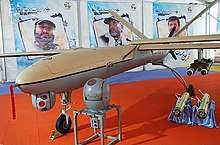
Development began in 2005 when Iran Aircraft Manufacturing Industrial Company (HESA) began design work on the HESA-100 UAV. This was essentially the same design as the Shahed 129 but was shorter and with a squarish fuselage. Design responsibility was transferred to Shahed Aviation Industries Research Center, which renamed the HESA-100 the Shahed 123. Though little is known about it, the Shahed 123 is a production UAV in its own right, not a research project. The Shahed 123 was later developed into the Shahed 129.[3] Both Shahed Aviation Industries and HESA have close ties to the IRGC.[5]
Two prototypes were built.[6] The first, with model number 129-001, first flew in spring 2012[3] and was first used operationally to livestream footage of ballistic missile tests on July 13, 2012.[6] The second prototype, with airframe model 129-002, flew in June 2012. The Shahed 129 was first seen in Iran's "Great Prophet 7" war games exercise in September of that year.[7][8] The aircraft was formally unveiled in September 2013 when it entered full-rate production.[3]
The UAV is assembled by HESA.[2] A total of 40 aircraft have been ordered, with deliveries scheduled to be completed by 2024.[3] They are built at a rate of about three per year.[3]
Design
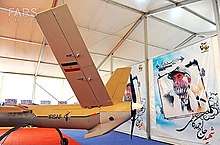
The Shahed 129 is a large single-engine propeller-driven UAV with V-tail vertical stabilizers, high-mounted straight wings, and a pusher configuration, generally similar to the MQ-1 Predator.[3] It has a long, narrow cylindrical fuselage approximately 65-75 cm in diameter, and is fabricated from composite material with an aluminum alloy superstructure.[3] It has a chin-mounted gimbal electro-optic/infrared sensor for day/night missions, retractable landing gear,[lower-alpha 1] and a real-time video data link.[9] The Shahed 129 is powered by one Rotax 914 aircraft engine and has two twin hardpoints, for a total of up to four munitions.[3]
Originally, the Shahed 129 carried Sadid anti-tank guided missiles,[2] also known as Sadid-361 or Fat'h 362 missiles.[3] This is a TV-guided anti-tank missile derived from Iran's Toophan missiles[10] and is described by multiple sources as similar in design to the Israeli Spike-ER missile.[5][6] The Sadid was not operationally deployed; one source says this was due to problems with the launcher mechanism and guidance system,[6] while another source says that R&D was not completed because American sanctions prevented Iran from obtaining necessary components.[11] Later, this was replaced by the Sadid-345 precision-guided munition,[12] which uses television and infrared seekers.[3] This PGM was developed from a previous version called the Sadid-341 by adding guidance fins.[6] Iranian sources claim the UAV can carry up to eight weapons, but in practice it is not seen with more than four.[5]
Given that Iran regularly makes misleading claims about their UAVs, and that Shahed-129 made no known drone strikes for its first four years of flight, there were long doubts about the Shahed-129's claim to be a legitimate strike UAV. Since 2016, there is a general consensus that it is in fact a legimitate UCAV capable of lethal force.[13]

Though the Shahed 129 airframe is likely capable of its claimed 1700km combat range, it relies on a ground control station, which Iranian state media say is limited to a 200 km datalink.[9] Independent analysts are more positive, saying the effective range is likely 300-400 km, but are clear that the drone's reliance on a ground station severely circumscribes its effective range.[3] The drone can use an autopilot system, similar to that used on the Karrar UAV, to follow predefined way-points beyond its control station's communication range. The Shahed is claimed to have a 24 hour endurance, which is is considered plausible but has not been independently verified.[11]
Operational history
In May 2014, two Shahed 129 aircraft were disassembled and airlifted on an Ilyushin Il-76 strategic airlifter to Damascus International Airport, along with their ground control stations and associated support crews, for use in the Syrian Civil War.[6] The UAVs' first mission was to support the Quds Force and its militia allies.[6] On April 10, 2014, rebels in Syria recorded a UAV resembling a Shahed 129 flying over Eastern Ghouta, Damascus.[14][15] The war in Syria proved a good environment to test the Shahed 129, and three more were later transferred to Syria, where they are operated from Syrian Air Force bases.[6] A Shahed 129 with what appears to be a single munition was spotted in the sky south of Aleppo in November 2014.[16] The Shahed 129 made its first known drone strike in February 2016, which was the first wartime drone strike by Iran.[17][2] A Shahed 129 was also used to provide bomb damage assessment for the 2017 Deir ez-Zor missile strike.[6] The Shahed 129s have since performed hundreds of sorties in Syria against the Islamic State and rebel forces.[6]
Two Shahed 129s were transferred to Iran's border with Pakistan in 2015, and were later supplemented by two more.[6] Iranian military officials say that Shahed 129 UAV can increase Iran's surveillance capabilities in border areas such as the Persian Gulf and the Sea of Oman.[18] Mohammad Ali Jafari described the UAV as "smart, accurate and inexpensive."[19] Shahed 129s have been broadly dispersed and are not operated from any central airbase. As of 2017, two Shahed 129s were based in Damascus, Syria, three in Tactical Air Base 10 near[20] Konarak, four in Bandar-Abbas, two on Abu Musa, and one in Urmia.[3] Some number are also stationed in Semnan.[6] In Syria, satellite imagery has also placed Shahed 129s at Hama Air Base[21] and T4 airbase.[22] In general, Iran has said little about the Shahed-129's use in Syria.[13]
On 8 June 2017, one of the five Shahed 129s deployed to Syria[6] attempted to conduct an airstrike against coalition personnel near al-Tanf, Syria, attacking them with one munition.[4] Though the airstrike "was clearly meant as an attack on the coalition forces and partner forces in the area", it failed to damage any American or partner equipment and failed to injure or kill any American or partner personnel,[4] because the munition failed to explode.[23] The Shahed 129 was shot down by an American F-15E Strike Eagle.[24]
Days later, on 20 June 2017, another F-15E Strike Eagle shot down another Shahed 129 drone again near Al-Tanf.[25] The drone approached in a similar manner to the previous incident and was shot down before it reached the range at which it could deploy its weapons.[26]
One day later, on 21 June 2017, a Pakistani JF-17 shot down a Shahed 129 after it entered Pakistani airspace near Panjgur.[27] It flew about 3-4 km into Pakistani airspace.[28]
Overall, three Shahed 129s have been shot down. An additional aircraft crashed in 2015 near Chabahar[29] and is believed to have been rebuilt.[6]
Variants
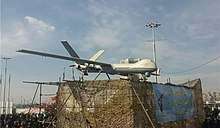
A new Shahed 129 variant distinguishable by a bulging nose was developed by Shahed Aviation Industries in 2015 and revealed in February 2016. Iranian sources say this satellite navigation will extend the range of the UAV.[30] On the other hand, sources hostile to the Iranian regime say that as Iran has no satellites, the bulbous nose cannot provide satellite guidance.[3] Iran has not commented on the purpose of the redesigned nose, and Jane's speculates it could house a Ku-band beyond-line-of-sight satellite link or synthetic aperture radar.[31] In addition, the payload is increased by 100 kg and the range is increased to 3000 km, according to Iranian state-run news.[3]
Operators
Specifications (Shahed 129A)
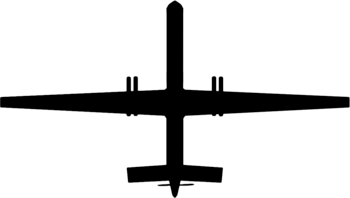
Data from Aviation Week[3] unless otherwise cited
General characteristics
- Crew: none
- Capacity: 400 kg payload
- Length: 8 m (26 ft 3 in)
- Wingspan: 16 m (52 ft 6 in)
- Height: 3.1 m (10 ft 2 in)
- Max takeoff weight: 990[2] kg (2,183 lb)
- Powerplant: 1 × Rotax 914 four cylinder, four stroke aircraft engine
- Propellers: 3-bladed
Performance
- Cruise speed: 150[32] km/h (93 mph; 81 kn)
- Combat range: 1,700 km (1,056 mi; 918 nmi)
- Ferry range: 3,400[32] km (2,113 mi; 1,836 nmi)
- Endurance: 24h
- Service ceiling: 7,300 m (24,000 ft)
Armament
- Bombs: 4 × Sadid 345 PGM
Avionics
Oghab-6 electro-optical/infrared sensor[lower-alpha 2]
Laser range finder
See also
Aircraft of comparable role, configuration and era
Related lists
References
- ↑ International Institute for Strategic Studies (IISS) (14 February 2018). "The Military Balance 2018". The Military Balance. Routledge. 118.
- 1 2 3 4 5 Gettinger, Dan (December 2016). "Drones Operating in Syria and Iraq" (PDF). Center for the Study of the Drone at Bard College.
- 1 2 3 4 5 6 7 8 9 10 11 12 13 14 15 16 17 18 19 20 21 22 23 24 25 Taghvaee, Babak (September 2017). "Battle-Tested: A brief history of Iran's combat UAV recently shot down by U.S. F-15s". Aviation Week & Space Technology. August 14 – September 3: 60.
- 1 2 3 Col. Ryan Dillon (June 8, 2017). "Inherent Resolve Spokesman Briefs Reporters". Combined Joint Task Force - Operation Inherent Resolve – via Defense Visual Information Distribution Service (DVIDS).
- 1 2 3 Galen Wright (29 February 2016). "Examining Iranian Drone Strikes in Syria".
- 1 2 3 4 5 6 7 8 9 10 11 12 13 14 15 Taghvaee, Babak (27 June 2017). "شاهد ۱۲۹، ستون فقرات نیروی پهپادی ایران" (in Farsi). BBC Persian.
- ↑ Cenciotti, David (4 July 2012). "Photo: Iran's brand new drones (including an Israeli UAV clone) exposed during recent wargames". theaviationist.com.
- ↑ "IRGC Announces Production of Drone with Missile Capability". Fars News. 16 September 2012. Archived from the original on 2012-09-19. Retrieved 2012-09-27.
- 1 2 "Iran's Shahed-129 Drone in Combat Operations in Syria". en.farsnews.com. 4 February 2016.
- ↑ "Babak Taghvaee on Twitter". Twitter. 27 June 2017.
- 1 2 Rawnsley, Adam (5 September 2014). "Like It or Not, Iran Is a Drone Power".
- ↑ "Iran unveils production line of Sadid-345 smart bomb system – Defence Blog". defence-blog.com. 29 June 2017.
- 1 2 Rawnsley, Adam (9 June 2017). "Drone War Heats Up in the Skies Over Syria". The Daily Beast.
- ↑ Cenciotti, David (10 April 2014). "Iranian Shahed 129 drone appears over Damascus". theaviationist.com.
- ↑ Jeremy Binnie (13 April 2014). "New UAV spotted over Damascus". London: IHS Jane's Defence Weekly. Archived from the original on 15 April 2014.
- ↑ "Galen Wright on Twitter". Twitter. 24 Nov 2014.
- ↑ Jeremy Binnie. "Analysis: Syrian rebel video corroborates Iranian UAV strike claims". London: IHS Jane's Defence Weekly.
- ↑ "توضیح سلامی درمورد قدرت موشکی ایران" (in Farsi). Mashregh News. 26 September 2012.
- ↑ "ساخت پهپاد شاهد 129 امنیت جای جای ایران اسلامی را در پی دارد ساخت RQ170 ايراني". YJC.
- ↑ "Drone Activity in Iran". 4 June 2016.
- ↑ "Dan Gettinger on Twitter". Twitter. 10 October 2017.
- ↑ Lyamin, Yuri (20 March 2018). "Сирийская авиабаза Т4 после израильского удара в феврале" (in Russian).
- ↑ Lara Seligman (14 September 2017). "How U.S. F-15E Drone Shoot-Down Changed Air Game In Syria". Aviation Week & Space Technology.
- ↑ Trevithick, Joseph (8 June 2017). "F-15E Shot Down "Predator-Sized" Drone That Attacked Coalition Forces In Syria". The Drive.
- ↑ US Central Command/CJTFOIR (20 June 2017). "Coalition shoots down armed UAV in Syria".
- ↑ Col. Ryan Dillon (June 23, 2017). "Operation Inherent Resolve Update - Col. Ryan Dillon". Combined Joint Task Force - Operation Inherent Resolve – via Defense Visual Information Distribution Service (DVIDS).
- ↑ "Pakistan confirms shooting down Iranian drone". The Express Tribune. 22 June 2017.
- ↑ "وزارت خارجه پاکستان تایید کرد پهپاد سرنگون شده متعلق به ایران است". BBC. 22 June 2017.
- ↑ Jeremy Binnie (16 August 2015). "Iranian Shahed-129 UAV crashes". London: IHS Jane's Defence Weekly.
- ↑ "Iran Joins Satellite-Guided Armed UAV Club". Operational Environment Watch: Foreign News & Perspectives of the Operational Environment. Foreign Military Studies Office. 6 (5): 8. May 2016.
- ↑ Gareth Jennings (18 February 2016). "Iran reveals redesigned Shahed-129 UAV". London: IHS Jane's International Defence Review.
- 1 2 "AviationsMilitaires.net — HESA Shahed 129". www.aviationsmilitaires.net.